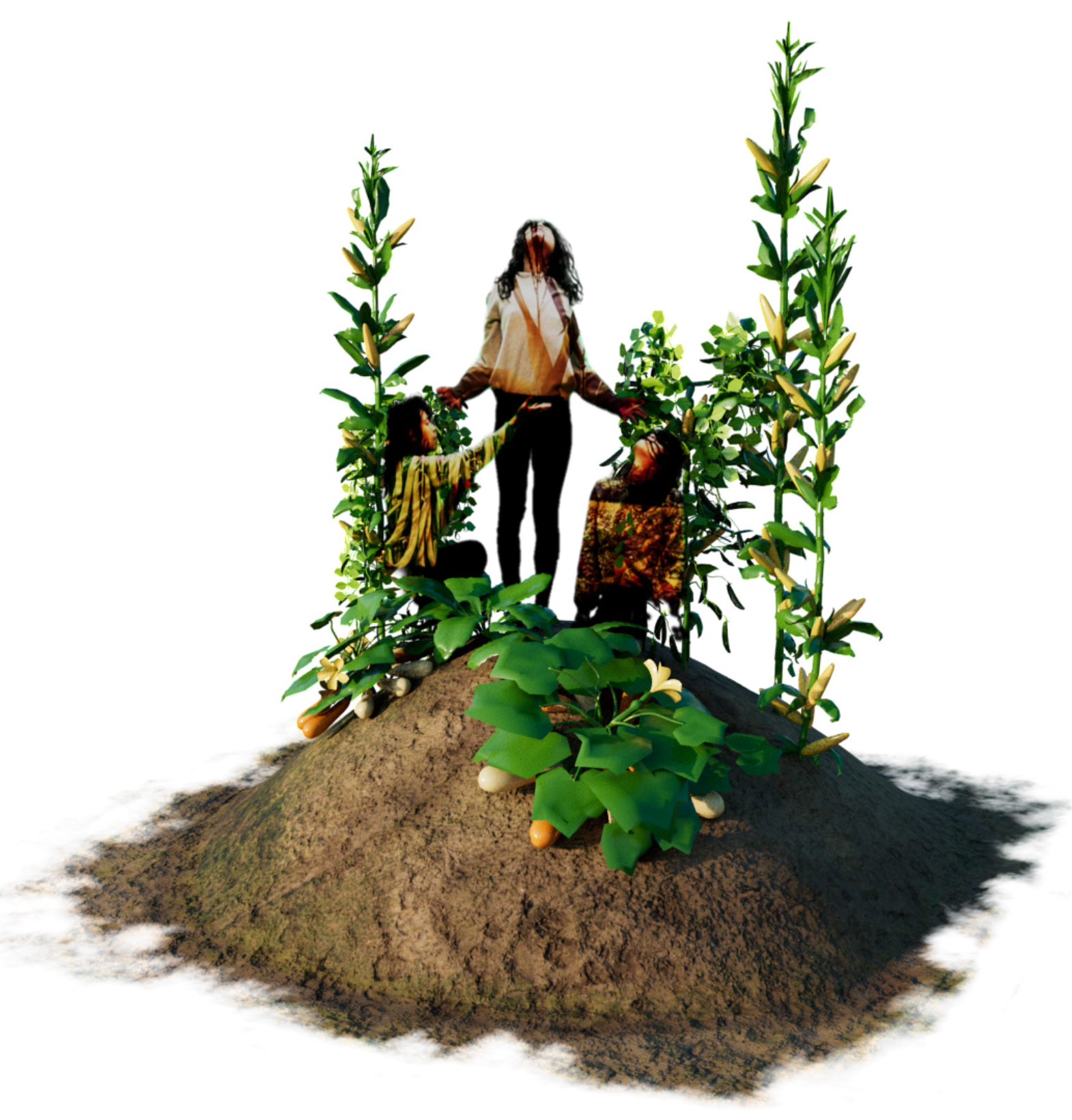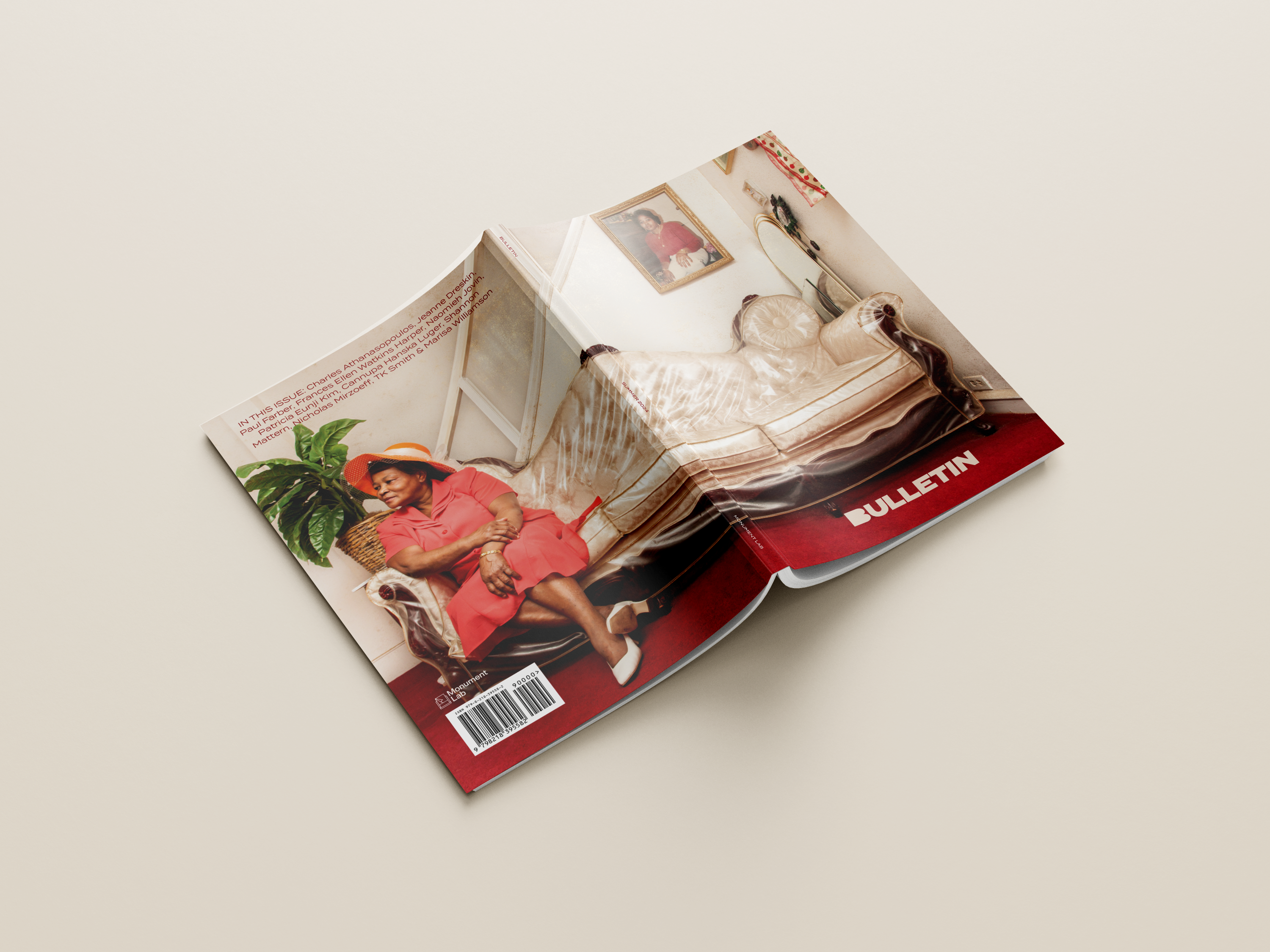Unsettling Grounds is an augmented reality (AR) exhibition and interactive storytelling tool showcasing experimental and monumental works by Black, Brown, Indigenous, and rural artists. Inspired by Historic Woolen Mills in Charlottesville, Virginia, Unsettling Grounds invites audiences to uncover hidden histories of lesser-known struggles for freedom. Lead artist Marisa Williamson and Black cultural theorist Charles Athanasopoulos reflect on Unsettling Grounds as an artistic practice that haunts Charlottesville and narratives of its history.1
Charles Athanasopoulos (CA): Unsettling Grounds confronts audiences with the way that past slavery and genocide continue to inform the present. It uses this new cutting-edge technology to show us how that past is all around us, how we walk by ghosts every day in our various spaces. It literally augments the way we perceive our surroundings. What attracted you to creating a digital application that augments reality? What are the implications you considered around that choice?
Marisa Williamson (MW): What drew me into the world of augmented reality was how it seemed to capture the essence of history itself—a blend of the past and the present. In 2017, Monument Lab commissioned me to make a prototype monument for Weccacoe Playground in Philadelphia. I connected with the developers at Dream Syndicate, and we created Sweet Chariot, a mobile app and augmented reality treasure hunt throughout the city of Philadelphia. The tech team’s willingness to collaborate over the years has allowed us to create meaningful projects that speak to the power of multicultural coalitions in the past, present, and future; this was a motivating feature when conceiving of Unsettling Grounds.
New technology is about exploration and social connection for me. I still use AR in the classroom. Just this semester, my students made parafictional postcards for speculative monuments and hidden histories on campus. The works sparked a meaningful conversation about interrogating master narratives at our colonial school.
CA: Your work exemplifies creative disorder.2 You blend the past, present, and future, ultimately disordering the rigid master narrative of history, while forming new connections, new re/imaginings, new im/possibilities. These master narratives create rigid icons that constrain Black and Indigenous imagination and so there is a need to disorder those icons to create space for radical invention. That is why I understand Unsettling Grounds as an example of Black iconoclasm.3 It destroys this iconic historical narrative of Charlottesville to create space for contemplating those seemingly impossible re/imaginings. How did you choose which marginalized stories would be part of this haunting of Charlottesville?
MW: I wanted Unsettling Grounds to address histories in Charlottesville’s city center, UVA Grounds, Court Square (where a plaque marks the town’s slave auction), and the location where Sally Hemings was likely buried. However, when I started having conversations with Albemarle County officials about funding, they could only authorize work outside the city limits. I was forced to pivot to the Broadway Corridor and the Woolen Mills, but this was not the first time I had been challenged to push into new areas of research and community connections.
I recruited artists from around and beyond the county, like Kweisi Morris, April Branham, and Tanesha Hudson, who changed the way I was thinking about space and its history. I learned from Tanesha and from Amber Smith, who both have strong local ties to the land, that the boundaries of Charlottesville haven’t always been what they are now. I started to think of Charlottesville as part of a wider landscape rather than as a singular landmark. For example, there have been lots of “centers” in Albemarle County. When you travel through this region, you see signs and indications that remind you that every town is or was the center of someone’s world. Albemarle has a rich history of settlements. Various groups found freedom in escape from elsewhere, here.
Not all of that comes to the surface in Unsettling Grounds, but we did manage to visualize a lot. I’m glad we could honor Monacan land use with the Three Sisters’ wigwam monument. The photo archive of the “five pillars” of the Black community—churches, family, businesses, leisure, and schools—in the sundial monument is a beautiful tribute to ancestors like mine who seemed to make a way out of no way in the segregated, post-Reconstruction South.
CA: What strikes me is how you let the ghosts and their stories guide your artistic practice, how you navigated various limits, engaged with various communities, and adapted your practice. In trying to unsettle the master narrative, your own practice was unsettled as you interacted with city officials and the ghosts themselves. I’m interested in how you draw on knowledge from one’s ancestors to pay tribute and form community without replicating a Western desire to produce an iconic master narrative of our own. It is to instead ask, what does the idea of “monument” look like when we’re outside the master’s house?4 What kinds of imaginative tools can we find from these Black and Indigenous ancestors? Unsettling Grounds presents these different fragments and traces of stories, giving the sense of a deep ecology5 of specters in the room with you wherever you are. Could you explain the ideas behind the creation of The Wheel? How does it relate to the transporting of audiences across time/space and the centering of body movement during this portion of the exhibition?

MW: The wheel was such a powerful early image. Spokes and gears—and their sounds—conjure the factory and agricultural countryside connected by horse cart highways and trains. The wheel emerged as an effective symbol for these interlocking and concentric social relations.
I dreamed that there would be a wheel in the work. So, I was excited to find that Kweisi Morris had also been dreaming of it; he had the idea and all the sketches. We felt the wheel had potential to diagram history and its recursive qualities. Kweisi and I talked about spirituals, especially “Ezekiel Saw the Wheel.” Although the biblical story was opaque to us, we liked the imagery, and came up with different versions: overlapping wheels, wheels inside wheels, wheels in the sky. While I agreed to make videos for each of the three wheels, it was a challenging process, and for a long time I was blocked.
The waterwheel symbolizes displacement, specifically the Middle Passage that cleaved Black people from their African roots. We also talked about representing the difficult reality of displaced Indigenous people, with Black folks living as stolen people on stolen land. Water was a theme running through all the monuments. Everyone hoped it would unify disparate threads.
I talked to Marie Tatti, our brilliant improvisational composer, about creating a work song. We, too, were attracted to “Ezekiel Saw the Wheel” and wondered if we could update the message of salvation using the water motif. We talked about creating a sonic landscape that dealt with the challenge of restoring Black song, joy, and breath. Her tracks do that. When I heard them, it was like surfacing for air.
Though Marie’s song laid a strong foundation and gave me a rhythm to cut to, Myra Anderson’s untitled spoken word poem provided the imagery needed for the video. After Myra recorded her voice, I could add the accompanying visual metaphors of water, fire, darkness, light, wind, sun, and ground that she so brilliantly illuminated with words.
This monument came together using strategies our ancestors used. It was a cypher, or a circle of storytellers riffing on the lines of the last. The tambourine, an instrument that has been played in Africa since antiquity, symbolized Black joy in the wheel monument. I was able to access that creative joy only when it was illuminated by this collaborative process. In the wheel monument, the gear frames images of Black workers. The waterwheel, the tambourine, and the gear move together like a gyroscope. This monument speaks to a shared struggle to balance and orient ourselves in relation to these timeless themes.
The wheel is a tough first monument experience to hack. For folks not used to interactive AR, it is not intuitive. I take seriously ideas brought up in Amiri Baraka’s 1970 essay, “Technology and Ethos.”6 Among them is the idea that technology can empower and disempower marginalized communities. Obviously, I want technology to empower, but I am still figuring out how that works. I knew I didn’t want to make a video game, so many of which allow users to slip into the bodies of others. Unsettling Grounds is about you being inside yourself. My hope for Unsettling Grounds is that people will use the app together and be circled, moved by, and connected across generations through the effort to unlock these stories.
CA: I love this idea of a cypher where different stories are riffing off each other in a dynamic flux against the rigidity of the colonial world. The cypher makes me think of Frantz Fanon’s idea that “the real leap consists in introducing invention into existence.”7 I kept thinking of that line when Unsettling Grounds transported me in great leaps across space and time, as part of traversing the wheel. In taking these leaps, I found myself unsettled in these liminal spaces, where new ideas and practices, informed by Black and Indigenous communal knowledges, were being invented on the spot, working against the white colonial desire to produce an iconic historical narrative. It is by always turning inward and toward the community to think about our own limitations and what we need, that we might radically invent something currently unthought. To that point, can you explain the importance of the statue of Thomas Jefferson that melts and/or reconstructs (depending on how you move) by Sandy Williams IV, and the conversation about fatherhood, abandonment, and Blackness between you and your interlocutors?
MW: This monument is so dear to me. I had been using the Sally Hemings persona for many years as a “tool” for unsettling institutional spaces in the art world. Thomas Jefferson, on the margins of that work, has become more of a focus of critique now that I work at UVA. I was always keen on lifting up Sally Hemings and her love and commitment to freedom for her children and family. But now, it really is Jefferson who needs to be taken down a notch!
Melting the Jefferson statue was an idea that Sandy brought to the table. Sandy has been casting wax monuments and melting them for years. We ran into some disagreement around what, if any, additional elements might be added to complicate or deepen the AR experience.
At the group meeting in March 2023, Sandy and I had a breakthrough—Sandy floated a theory about Jefferson being the first “absentee Black dad.” We all started riffing. Folks were describing what it was about Jefferson that really ticked them off. Myra is a descendant of enslaved families at Monticello. Brandon, whose voice you hear on the track, is a teacher and performer with a deep embodied understanding of Virginia history. Photographer Jay Simple (also on the track) is a hilarious and astute critic of the ways history is reenacted through visual culture. Sandy and I share an obsession with the psychology of landscape, the personal-as-political, and the need to make and leave space for nuance. Talking with others about ideas that have haunted our lives and practices for years was both cathartic and constructive. It was a moment of playful takedown and uplift. We suffer from colonized ways of thinking: spiraling thoughts that live, rent-free, and unwelcome in our minds. This monument was like a little group therapy session.
We talk about making monuments for the future—about building the kinds of structures that future generations will be grateful for. But more immediately, these monuments are for ourselves. I love replaying and rewinding this monument like a home movie full of artfully thrown shade and shared experience. Jefferson is an unsettling part of what makes Albemarle County and America our home. But we—the chorus of descendants of the enslaved and Indigenous people from across the globe—make life here possible; clearing the air, turning the soil, digging things up so new ideas can be planted and grown.

About Bulletin
This story is featured in the inaugural print issue of Bulletin, a public art and history print journal offering perspectives on critically reading and reimagining monuments. We collaborate with artists, scholars, curators, activists, and writers to question the symbols and systems that we have inherited—and to envision new directions and pathways for public memory.
Edited by Patricia Eunji Kim, this issue explores the theme of “Ghosts.” Contributors Charles Athanasopoulos, Jeanne Dreskin, Paul Farber, Frances Ellen Watkins Harper, Naomieh Jovin, Cannupa Hanska Luger, Shannon Mattern, Nicholas Mirzoeff, TK Smith, and Marisa Williamson consider the specters, haunting sensations, and eerie remnants of the past as they relate public art, space, and memory. Learn more and buy a physical copy of the full Bulletin today!

